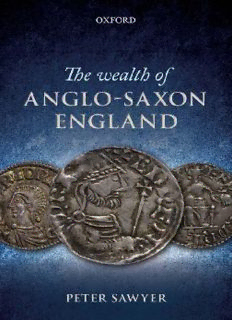
The Wealth of Anglo-Saxon England PDF
Preview The Wealth of Anglo-Saxon England
the wealth of anglo-saxon england This page intentionally left blank The Wealth of Anglo-Saxon England Based on the Ford Lectures delivered in the University of Oxford in Hilary Term 1993 P ETER S AWYER 1 3 Great Clarendon Street, Oxford, ox26dp, United Kingdom Oxford University Press is a department of the University of Oxford. It furthers the University’s objective of excellence in research, scholarship, and education by publishing worldwide. Oxford is a registered trade mark of Oxford University Press in the UK and in certain other countries © Peter Sawyer 2013 The moral rights of the author have been asserted First Edition published in 2013 Impression: 1 All rights reserved. No part of this publication may be reproduced, stored in a retrieval system, or transmitted, in any form or by any means, without the prior permission in writing of Oxford University Press, or as expressly permitted by law, by licence or under terms agreed with the appropriate reprographics rights organization. Enquiries concerning reproduction outside the scope of the above should be sent to the Rights Department, Oxford University Press, at the address above You must not circulate this work in any other form and you must impose this same condition on any acquirer British Library Cataloguing in Publication Data Data available ISBN 978–0–19–925393–7 Printed in Great Britain by MPG Books Group, Bodmin and Kings’s Lynn Links to third party websites are provided by Oxford in good faith and for information only. Oxford disclaims any responsibility for the materials contained in any third party website referenced in this work. PREFACE The Ford Lectures on which this book is based were delivered in 1993. The delay has been partly due to previous commitments and the disruption caused by two removals, to Trondheim in 1996 and to Uppsala in 2006. In 2008 I began revising the fi rst version in the light of very helpful comments by a reader for the Press, but this work was soon interrupted for two years by a serious illness. I have tried, with incomplete success, to take account of publications that have appeared since 1993. I n the fi rst place I wish to thank the electors to the Ford Lectureship for inviting me. Many friends and colleagues have helped to keep me up to date by sending references and supplying books and papers, many in advance of publication. I am particularly grateful to Mark Blackburn and Stewart Lyon for criticizing early drafts of several chapters, and for the guidance they, together with Michael Metcalf, Martin Allen, and Rory Naismith, have given on the numismatic e vidence. Stewart Lyon has kept me informed about the progress of his work on the Winchester and York mints, and has generously allowed me to use his results in advance of their publication. Thanks are also due to many others who have, at various stages, helped with advice and criticism: Marion Archibald, Martin Biddle, John Blair, Wolfgang Brockner, Nicholas Brooks, Donald Bullough, James Campbell, Simon Coupland, Michael Dolley, David Dumville, Christopher Dyer, Robin Eagleton, Mary Garrison, Malcolm Godden, James Graham-Campbell, Dennis Green, Philip Grierson, Sally Harvey, Gert Hatz, Joyce Hill, Kenneth Jonsson, Derek Keene, Susan Kelly, Jane Kershaw, Simon Keynes, Susan Kruse, Michael Lapidge, preface John Latham, Kevin Leahy, John LePatourel, John Maddicott, Brita Malmer, John Moore, Janet Nelson, John Newman, Pamela Nightingale, Terence O’Connor, Elizabeth Pirie, Nigel Ramsey, Timothy Reuter, Dieter Rosenthal, Harold Schneider, Richard Sharpe, Ian Short, Colin Smith, Ian Stewart (Lord Stewartby), Katharina Ulmschneider, Alan Vince, Leslie Webster, Ian Wood, Patrick Wormald, and Ulrich Zwicker. I am also indebted to Kungl. Vetenskaps- och Vitterhets- Samhället i Göteborg for grants that enabled me to discuss this work with colleagues in England and to use the Sackler Library in Oxford. My greatest debt is to my wife for her enthusiastic support from the start in 1989. She has patiently read, and criticized, several ver- sions of the whole book. The result, however imperfect, is much the better for her advice. vi CONTENTS List of Figures ix List of Tables x List of Abbreviations x i 1 Introduction 1 2 Tempore Regis Edwardi 10 3 From Solidi to Sceattas 32 4 The Eighth and Ninth Centuries 6 1 5 From Edward the Elder to Edward the Confessor (899–1066) 87 6 ‘Whoever has cash (denarios) can acquire anything he wants’ 1 11 Appendix: Estimating Dies, Coins, and Currency 1 15 References 127 Index 147 LIST OF FIGURES 1 Pennies of Edgar, Æthelred II, and Cnut 5 2 Annual values in 1086 18 3 Annual values per team in 1086 19 4 Solidus of Justinian I 48 5 Merovingian tremissis and Anglo-Saxon thrymsa 5 4 6 Frisian and Anglo-Saxon sceattas 5 7 7 Histogram: single coin fi nds from southern England, 600–1180 5 8 8 Map: single fi nds of sceattas in England 7 5 9 Penny of Offa 78 10 Penny of Alfred 8 4 11 Map: mints of Athelstan 9 2 12 Eleventh-century French and German coins 1 13 F or permission to reproduce illustrations, thanks are due to The Syndics of the Fitzwilliam Museum, Cambridge (fi gs. 1,4,5,6,9,10, 12); Cambridge University Press (fi gs. 2,3); Oxbow Books (fi g. 7); British Numismatic Society (fi gs. 8,11). All coins are shown at double their original size. LIST OF TABLES 1 Single coin fi nds in the Danelaw and elsewhere in England 9 0 2 Average number of reverse dies used per year in Winchester, York, and Lincoln, c .973–1066 120 3 Estimates of the number of reverse dies used in the Lincoln mint, c.973–1066 121 4 Estimates of the number of reverse dies used in the mints of Winchester, York, and Lincoln, c.973 and 1066 122 5 Single fi nds of coins from 978 to 1135 recorded before 1 April 2004 125
